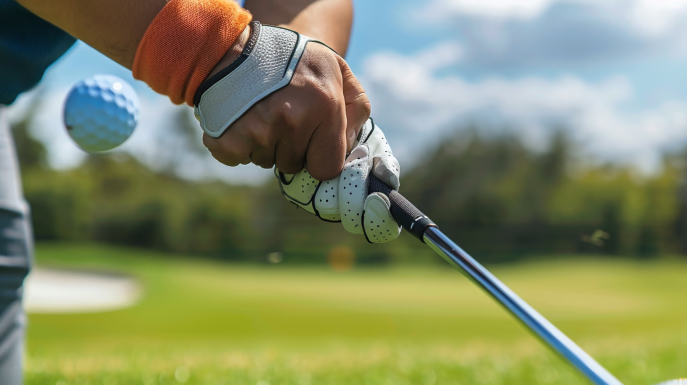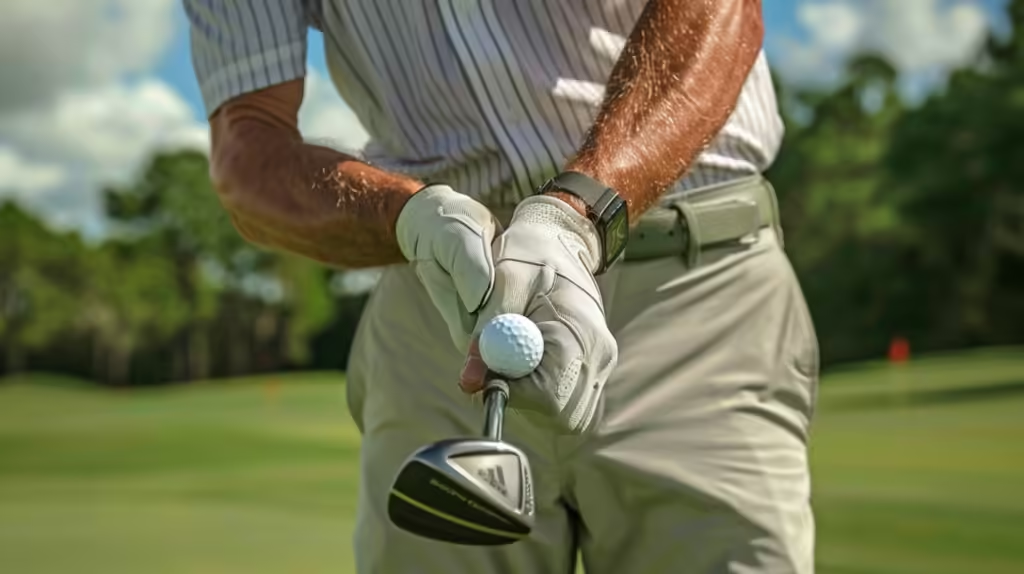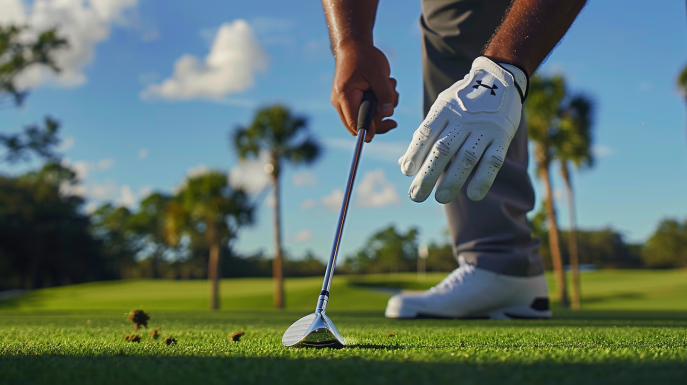Get the Perfect Golf Swing Wrist Action for Consistency

Source : pinnaclegolfpros copyright
Mastering the perfect golf swing wrist action is crucial for consistency, distance, and accuracy. The wrists play a vital role in hinging, cocking, and releasing the club properly, which in turn affects the swing path, clubface control, and overall power generation. This article will explore the biomechanics of proper wrist action, provide tips and drills from professional golfers, and offer solutions for common wrist-related issues that can hinder a golfer’s performance.
Key Takeaways
- The wrists control the hinge, flexion, and extension of the club throughout the swing sequence, affecting power, consistency, and accuracy.
- Proper wrist action in the backswing creates lag and stored energy for a powerful downswing release.
- Maintaining consistent grip pressure and a smooth swing tempo are crucial for developing a repeatable wrist action.
- Analyzing wrist action with video and feedback tools can help identify and correct technical issues in the swing.
- Improving wrist flexibility, strength, and stability through golf-specific fitness routines can enhance wrist function and swing performance.
Understanding the Importance of Wrist Action

The wrists play a crucial role in the game of golf, as they control the hinge, flexion, and extension of the club throughout the swing sequence. Proper wrist action is essential for generating power, maintaining consistent swing path, and achieving optimal clubface control.
Wrist Hinge and Flexion in the Backswing
In the backswing, the wrists should hinge and flex properly to create a “lag” position, where the club lags behind the hands and arms. This lag position stores potential energy that can be released during the downswing, allowing the golfer to generate increased clubhead speed and distance. The wrist hinge and flexion are essential for building the proper swing mechanics and muscle memory.
Wrist Extension and Clubface Control in the Downswing
During the downswing, the wrist extension and the release of the clubface are critical for controlling the clubface and maintaining a consistent swing path. As the golfer transitions from the backswing to the downswing, the proper wrist extension and release enable them to square the clubface at impact, ensuring a more accurate and consistent shot.
Consistency Through Proper Wrist Action
Developing a consistent wrist action is key to achieving repeatability in the golf swing. By mastering the biomechanics of wrist hinge, flexion, extension, and release, golfers can build a swing sequence that produces consistent ball flight, distance, and accuracy. Consistent wrist action also helps to improve muscle memory, allowing golfers to execute their desired shots with confidence and precision.
Mastering the Grip Pressure and Swing Tempo
The grip pressure and swing tempo are intricately linked to the proper wrist action in the golf swing. Maintaining a consistent grip pressure throughout the swing allows the wrists to hinge and release smoothly, without excessive tension or grip pressure changes. This consistency in grip pressure helps build muscle memory and promotes swing repeatability, leading to more consistent shots and swing precision.
Maintaining Consistent Grip Pressure
A firm yet relaxed grip pressure is essential for allowing the wrists to function optimally during the swing. Applying too much grip pressure can lead to wrist inflexibility and restrict the natural hinging and releasing motion of the wrists. Conversely, a grip pressure that is too light can result in a lack of control and stability during the swing. By finding the sweet spot of consistent grip pressure, golfers can enhance their wrist strength and golf swing mechanics, enabling them to execute the desired wrist actions, such as the proper wrist hinge and lag in the golf swing.
Developing a Smooth and Rhythmic Swing Tempo

The swing tempo is a critical factor in the coordination of the wrists throughout the golf swing. A smooth and rhythmic tempo ensures that the wrists can move through the swing sequence with proper timing and coordination, from the backswing wrist hinge to the wrist release in the downswing. By developing a consistent swing tempo, golfers can enhance their hand action, forearm rotation, and overall swing path, leading to more consistent shots and swing precision.
Backswing Wrist Action for Power and Control
The wrist hinge and flexion during the backswing are crucial for generating power and maintaining control of the golf club. As the golfer takes the club back, the wrists should hinge and flex to create a “lag” position, where the club lags behind the hands and arms. This lag position stores potential energy that can be released during the downswing for increased clubhead speed and distance.
Proper wrist stability and biomechanics are essential for executing the perfect backswing wrist action. Pro golfer techniques and golf instruction emphasize the importance of maintaining wrist flexibility, wrist rotation, and wrist strength to ensure a smooth, controlled backswing that sets the stage for a powerful and consistent downswing.
By focusing on developing a golf swing wrist action that involves a well-timed wrist hinge and wrist flexion, golfers can unlock the potential for power generation and swing repeatability, leading to more consistent shots and swing precision.
Downswing Release and Impact Position
The wrist extension and release during the downswing are crucial for achieving maximum power and consistent ball striking. As the golf club travels down towards the ball, properwrist extensionallows the golfer to square theclubfaceand deliver the clubhead with precision to theimpact position. Thiswrist releaseis a key component of thegolf swing sequence, directly affecting theswing path consistencyand overallpower generation.
Proper Wrist Release for Maximum Power
Professional golfers and instructors emphasize the importance of a fluid, well-timed wrist release during the downswing. As the club transitions from the backswing to the downswing, the lead wrist action and forearm rotation work together to extend the wrists, squaring the clubface and unleashing the stored energy for maximum power generation. Maintaining a lag pressure in the lag position until the last moment helps ensure a smooth, consistent wrist release.
Impact Position and Swing Path Consistency
The precise wrist extension and clubface control at impact are crucial for producing consistent shots and swing path consistency. A properly timed wrist release allows the golfer to strike the ball with the sweet spot of the clubface, resulting in optimal ball flight and distance. Mastering the wrist action through the golf swing mechanics and sequence is a hallmark of elite-level golf swing analysis and pro golfer techniques.
| Wrist Action | Importance | Impact on Performance |
|---|---|---|
| Wrist Extension | Squaring the Clubface | Consistent Ball Striking, Swing Path Consistency |
| Wrist Release | Unleashing Power | Maximum Distance, Clubhead Speed |
| Proper Wrist Hinge | Maintaining Lag | Swing Repeatability, Consistent Shots |
Developing Muscle Memory and Swing Repeatability

Consistent wrist action in the golf swing is built upon developing muscle memory and a repeatable swing mechanics. The proper hand position, with the lead hand in a slightly stronger grip and the trailing hand in a more neutral position, helps establish the correct wrist hinge and release throughout the swing.
The Role of Proper Hand Position
Maintaining the appropriate hand position is crucial for consistent wrist action and reliable shot-making. By slightly strengthening the grip of the lead hand, golfers can better control the clubface and promote a proper wrist hinge during the backswing. The trailing hand should adopt a more neutral position, allowing the wrists to work in harmony and deliver a clean, repeatable release at impact.
Practicing Swing Mechanics with Training Aids
Incorporating training aids into your practice routine can be a valuable tool for developing muscle memory and improving swing repeatability. Devices that restrict or guide the wrist action, such as wrist braces or swing guides, can help golfers ingrain the correct hand action, forearm rotation, and proper wrist hinge required for consistent, precise shots. Consistent practice with these aids can lead to a more reliable swing and better lag in the golf swing, as well as a smoother wrist release.
Golf Swing Wrist Action: Biomechanics and Injury Prevention
The biomechanics of the golf swing, particularly the wrist action, play a crucial role in both power generation and injury prevention. The wrist cock and snap action, where the wrists hinge and release the club, are key elements of the swing sequence that contribute to clubhead speed and distance.
Wrist Cock and Snap Action
The wrist cock refers to the hinging of the wrists during the backswing, which allows the golfer to create lag and store potential energy for a powerful downswing. The snap action occurs as the golfer unwinds and releases the club, transferring that stored energy to the ball for maximum distance.
Proper wrist flexibility, wrist rotation, and wrist strength are essential for executing the wrist cock and snap action effectively. Golfers who develop these attributes through targeted golf fitness and training are better equipped to generate clubhead speed while minimizing the risk of wrist-related injuries.
Wrist Stability and Joint Health
In addition to the dynamic wrist cock and snap action, maintaining wrist stability is crucial for the overall biomechanics of the golf swing. Golfers with strong, stable wrists are better able to control the clubface and maintain a consistent swing path, resulting in improved accuracy and distance control.
Regular golf fitness regimens that focus on wrist flexibility and wrist strength exercises can help golfers improve their wrist stability and reduce the risk of wrist-related injuries. By addressing the biomechanical demands of the golf swing, golfers can optimize their performance while protecting their long-term joint health.
Analyzing Your Swing: Video Analysis and Feedback Loops
Analyzing the wrist action in a golfer’s swing is crucial for identifying areas for improvement and making technical adjustments. By using high-speed cameras and video analysis, golfers and their coaches can closely examine the hinge, flexion, extension, and release of the wrists throughout the swing sequence.
High-Speed Camera Analysis
Advanced video analysis tools, such as high-speed cameras, allow golfers and coaches to capture their swing in meticulous detail. Frame-by-frame playback reveals the precise mechanics of the wrist action, including the timing and angles of the hinge, cock, and release. This invaluable feedback enables golfers to make targeted adjustments to their swing and improve their golf swing wrist action, leading to greater swing repeatability, consistent shots, and swing precision.
Wrist Sensors and Golf Apps
In addition to high-speed camera analysis, modern golf apps and wearable wrist sensors provide golfers with real-time data and feedback on their swing mechanics. These technologies can track the precise movements of the wrists, quantifying the golf swing sequence, lag position, hand action, and forearm rotation. By analyzing this data, golfers and their golf coaches can identify areas for technical adjustments and make informed decisions to improve their proper wrist hinge and wrist release golf swing.
The combination of video analysis and sensor-based feedback loops allows golfers to develop a deep understanding of their golf swing mechanics and swing path, ultimately leading to more consistent and precise golf swing wrist action.
Professional Tips and Drills for Perfecting Wrist Action
Seasoned professional golfers and renowned instructors offer invaluable insights and targeted drills to help golfers develop the perfect wrist action for their golf swing. These proven techniques focus on improving wrist flexibility, wrist strength, and the overall range of motion in the wrists, which are essential for executing the desired wrist hinge, wrist cock, and wrist release throughout the swing sequence.
Drills for Wrist Flexibility and Strength
Incorporating flexibility exercises and strength training routines into your practice regimen can significantly enhance your ability to properly control the wrists during the golf swing. Experts recommend a variety of drills, such as wrist rotation exercises, wrist flexion and extension movements, and grip strengthening activities to improve overall wrist health and function.
Online Golf Lessons and Coaching
In addition to personal instruction, many golf coaches and instructors now offer online golf lessons and video tutorials that focus specifically on wrist action and swing mechanics. These digital resources provide golfers with the opportunity to access expert guidance, video analysis, and customized golf drills tailored to their individual needs, allowing them to refine their wrist release, wrist golf swing drills, and wrist golf swing tips from the comfort of their own homes.
Golf Fitness and Flexibility for Optimal Wrist Action
Maintaining optimal wrist health and function is crucial for golfers looking to maximize their performance and avoid injury. Incorporating golf-specific fitness and flexibility routines can help improve the strength, range of motion, and stability of the wrists, which in turn enhances the golfer’s ability to execute the desired wrist action throughout the swing.
Strength Training for Power Generation
Golfers who prioritize strength training exercises that target the muscles supporting the wrists and forearms often see significant benefits in their ability to generate power and control the golf club. Exercises such as wrist curls, reverse wrist curls, and forearm rotations can help build the necessary strength and stability to execute a powerful, yet controlled, wrist hinge and release.
Flexibility Exercises for Improved Range of Motion
Improving the flexibility and mobility of the wrists is essential for optimal wrist action in the golf swing. Golfers should incorporate a variety of stretching and mobility exercises into their pre-round warm-up and post-round cool-down routines. This can include exercises like wrist circles, palm-up/palm-down stretches, and even using golf-specific training aids to enhance wrist flexibility and range of motion.
By focusing on both strength and flexibility training, golfers can ensure their wrists are prepared to handle the demands of the golf swing, reducing the risk of injury while also enhancing their ability to consistently execute the desired wrist action for power, control, and accuracy.
FAQ
What is the importance of proper wrist action in the golf swing?
The wrists play a vital role in the golf swing, controlling the hinge, flexion, and extension of the club throughout the swing sequence. Proper wrist action is essential for creating lag, generating power, maintaining consistent clubface control, and delivering the club to the ball with precision.
How does wrist hinge and flexion in the backswing contribute to power and control?
The wrist hinge and flexion during the backswing are crucial for generating power and maintaining control of the golf club. As the golfer takes the club back, the wrists should hinge and flex to create a “lag” position, where the club lags behind the hands and arms. This lag position stores potential energy that can be released during the downswing for increased clubhead speed and distance.
What is the importance of wrist extension and release during the downswing?
The downswing release of the wrists is a critical component of the golf swing, as it determines the clubface angle and swing path at impact. Proper wrist extension and release during the downswing allow the golfer to square the clubface and deliver maximum power to the ball.
How can golfers develop muscle memory and swing repeatability through proper wrist action?
Consistent wrist action in the golf swing is built upon developing muscle memory and a repeatable swing mechanics. The proper hand position, with the lead hand in a slightly stronger grip and the trailing hand in a more neutral position, helps establish the correct wrist hinge and release throughout the swing.
How do biomechanics and injury prevention relate to golf swing wrist action?
The biomechanics of the golf swing, particularly the wrist action, play a crucial role in both power generation and injury prevention. The wrist cock and snap action, where the wrists hinge and release the club, are key elements of the swing sequence that contribute to clubhead speed and distance. Maintaining proper wrist stability and joint health is essential for avoiding injuries.
What tools and techniques can golfers use to analyze and improve their wrist action?
Analyzing the wrist action in a golfer’s swing is crucial for identifying areas for improvement and making technical adjustments. By using high-speed cameras and video analysis, golfers and their coaches can closely examine the hinge, flexion, extension, and release of the wrists throughout the swing sequence. Additionally, wrist sensors and golf apps can provide valuable feedback on wrist mechanics and swing patterns.
What are some professional tips and drills for perfecting wrist action in the golf swing?
Professional golfers and instructors offer valuable insights and drills to help golfers develop the perfect wrist action for their golf swing. These include exercises to improve wrist flexibility, strength, and range of motion, as well as targeted drills that focus on the proper hinge, cock, and release of the wrists. Online golf lessons and coaching can also provide personalized guidance for improving wrist action.
How can golf-specific fitness and flexibility routines enhance wrist action and performance?
Maintaining optimal wrist health and function is crucial for golfers looking to maximize their performance and avoid injury. Incorporating golf-specific fitness and flexibility routines can help improve the strength, range of motion, and stability of the wrists, which in turn enhances the golfer’s ability to execute the desired wrist action throughout the swing.

